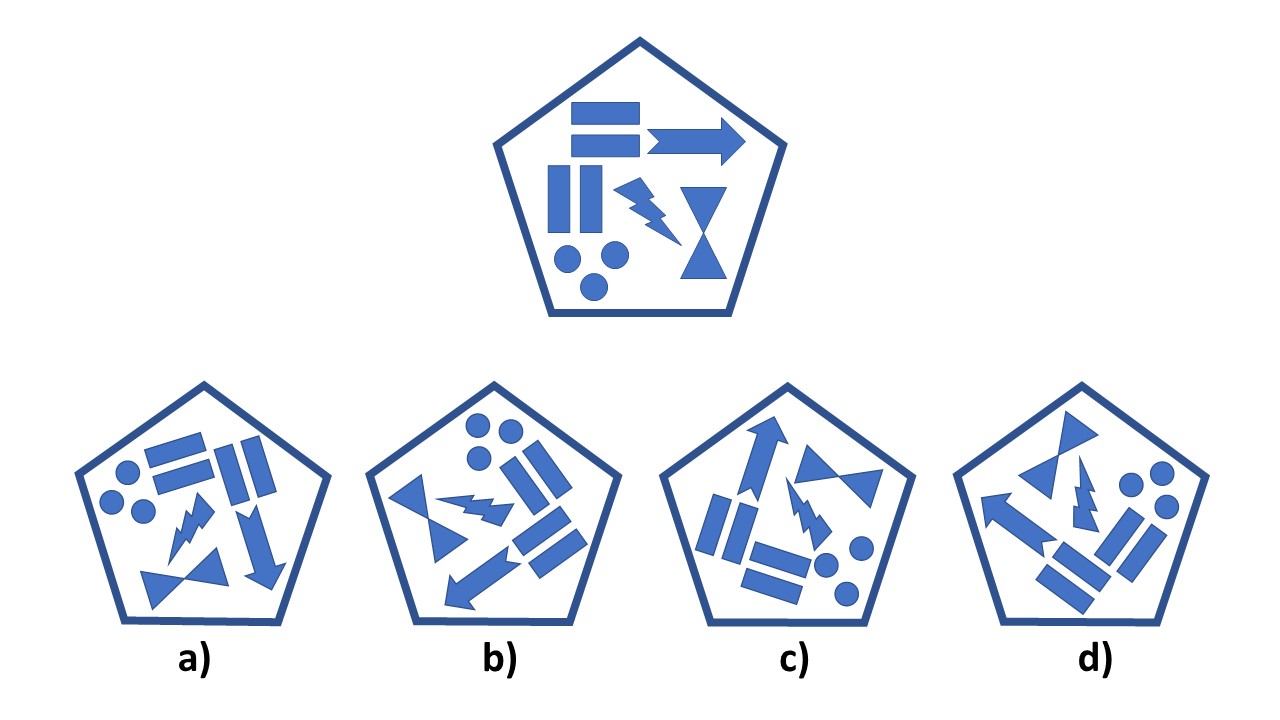The Hogan Business Reasoning Inventory (HBRI) Test (2025 Guide)
Updated May 31, 2024
- What Is the Hogan Business Reasoning Inventory Test?
- What Are The Reasoning Styles of the HBRI Test?
empty
empty
- Who Might Use the HBRI Test?
- What to Expect on the HBRI Test
empty
empty
- How Is the HBRI Assessment Scored and Reported?
empty
empty
empty
- How to Prepare for the HBRI Test in 2025
- Frequently Asked Questions
- Final Thoughts
Hogan is a leading provider of psychometric assessments widely used for the purpose of talent acquisition and development.
This article focuses specifically on the Hogan Business Reasoning Inventory (or HBRI). It covers everything you need to know about the test, including what to expect and what it can tell you about your reasoning style.
It also includes some Hogan Business Reasoning Inventory sample questions and some key tips for preparation.
What Is the Hogan Business Reasoning Inventory Test?
The Hogan Business Reasoning Inventory is a scientifically-led aptitude test that measures cognitive ability and reasoning style.
In simple terms, it looks at how you process information, your problem-solving and decision-making skills, and your ability to learn from mistakes so you don’t repeat them.
What Are The Reasoning Styles of the HBRI Test?
Reasoning styles play a significant role in how individuals process information, solve problems and make decisions.
There are two primary reasoning styles: quantitative reasoning and qualitative reasoning.
In this article, we will explore these two reasoning styles according to the Hogan Business Reasoning Inventory.
Quantitative Reasoning
What Is Quantitative Reasoning?
Quantitative reasoning refers to the ability to understand and solve problems using numerical and mathematical concepts.
This applies to how you evaluate and interpret quantitative information through the application of spatial and mathematical reasoning skills.
Quantitative reasoning is not limited to a specific academic discipline; it is a crucial skill in various fields, including mathematics, science, economics, finance, engineering and social sciences.
Qualitative Reasoning
What Is Qualitative Reasoning?
Qualitative reasoning is the process of understanding and explaining phenomena or systems without relying on precise numerical data.
Instead of using quantitative measures, qualitative reasoning involves describing and analyzing systems based on qualities, attributes, relationships and logical inference.
It is often used when precise quantitative information is not available or when dealing with complex systems that are difficult to model mathematically.
This is a more intuitive approach to problem solving and refers to how you process abstract information to form logical conclusions.
Who Might Use the HBRI Test?
The Hogan Business Reasoning Inventory is specifically designed for use within a business context and is widely held as one of the most reliable indicators of future performance in the workplace.
It not only identifies those with advanced business decision-making skills, but also helps to pinpoint areas for improvement.
It is because of this that the HBRI Test is used both for pre-employment selection and on the job development – most commonly for managerial level and leadership roles.
With that in mind, you may be asked to take the HBRI as part of the recruitment process or for professional development reasons throughout your career.
You can also opt to take the HBRI assessment as an individual should you want to learn more about your reasoning capabilities and any areas that require attention.
Practice the HBRI Test with TestHQ
What to Expect on the HBRI Test
Hogan Business Reasoning Inventory Question Types
The HBRI is a multiple-choice assessment comprising 24 questions. The questions fall into three category types:
- Verbal and logical reasoning – Questions here include word analogies and both deductive and inductive logic problems.
- Numerical reasoning – Questions here relate to things like area, distance and speed calculations, data interpretation from tables and graphs, and simple math problems.
- Abstract reasoning – Here you’ll need to work with abstract information in the form of 2D and 3D figures; for example, shape rotation.
The original Hogan Business Reasoning Inventory was designed without a time limit, taking on average around 25 minutes to complete. However, Hogan has since introduced a timed version with a 30-minute constraint.
Whether your test is timed or untimed will be down to the administering employer.
Practice an HBRI Test with TestHQ
Hogan Business Reasoning Inventory Sample Questions
HBRI Hogan Assessment Sample Questions – Verbal Reasoning
The most common type of question you’ll encounter here is word analogy. These require you to spot relationships between word pairs:
'Particular' is to 'fussy' as 'weak' is to:
a) Strong
b) Feeble
c) Brave
James has $6.57, Anne has $1.78 and Paul has $18.90. Two of them together could not have:
a) $8.35
b) $25.47
c) $27.25
d) $20.68
If you need to prepare for a number of different employment tests and want to outsmart the competition, choose a Premium Membership from TestHQ.
You will get access to three PrepPacks of your choice, from a database that covers all the major test providers and employers and tailored profession packs.

Which shape is not a rotation of the shape above?
How Is the HBRI Assessment Scored and Reported?
On completion of your Hogan Business Reasoning Inventory test, a detailed report will be issued, covering various aspects of your reasoning capabilities.
This report is split into three sections, as outlined below:
Overall Business Reasoning
Essentially, this is a mark of your overall performance across both quantitative and qualitative reasoning.
It is presented as a normative score; in other words, it ranks your performance on a sliding scale compared to the results of a normative group.
This scale is split into the four sections of low, average, high and very high, with your score shown as a percentage.
So, if you achieved 65%, this shows you have performed as well or better than 65% of the normative group and would place you within the high score category.
Your overall business reasoning score gives employers insight into how you’re likely to approach problems in the workplace and your ability to achieve a productive resolution.
For example, a high score range tells employers that you’re quick to process information, assess various sources of information carefully when making decisions and take a contextual approach to problem solving.

Qualitative and Quantitative Reasoning
This section breaks down your results to give a score range for each reasoning style.
This is a quartile-based normative score, from low to high.
For qualitative reasoning, people at the low end of the scale are practical learners – those who learn through experience – while those at the high end are capable of making sense of complex information.
For quantitative reasoning, those in the low score range make decisions based on instinct rather than quantifiable evidence. Those in the high score range are able to quickly identify the relevant data to solve a given problem.
Cognitive Style
When your qualitative and quantitative reasoning skills are combined, they define your overall cognitive style.
You’ll be assigned one of four styles that explains your approach to problem solving in greater detail:
- Expedient Thinker – These tend to be poor decision-makers who rely on gut feel rather than evidence and seek the easiest way out when faced with a problem.
- Contextual Thinker – These individuals are capable of devising a solution, but, in doing so, tend to overlook the finer details and fail to address any challenges that may stand in the way.
- Analytical Thinker – Those in this category are adept at problem solving but often neglect the bigger picture, over-analyzing instead of making assertive decisions.
- Critical Thinker – These are the most effective problem solvers. They weigh up the short and long term gains of any solution, and make decisions rooted in a broader business context.
As part of this section, you’ll also receive key personal insights pertaining to your unique strengths and weaknesses.
Practice an HBRI Test with TestHQ
How to Prepare for the HBRI Test in 2025
Success on your Hogan Business Reasoning Invetory test can help you land that dream job or bag that sought-after promotion, so it’s important to approach it methodically.
Here are some step-by-step tips on how best to prepare:
Step 1. Make Practice a Priority
Aptitude tests are unique in that they measure naturally occurring skills; in the case of the HBRI, cognitive ability.
Preparation for such tests is not a case of expanding your knowledge, but getting plenty of practice in applying your natural abilities.
When taking HBRI practice tests, you’ll exercise the skills you already have, making them sharper. You’ll find you solve problems at a quicker pace with greater accuracy, and your confidence will grow.
It’s advisable to purchase an HBRI preparation pack specifically designed to replicate the official assessment.
Step 2. Learn the Formats of the Questions
There are multiple question types within the HBRI, all focused on different aspects of reasoning.
To perform well, you need to understand the format of each, since unfamiliarity will lead to stress and confusion.
Once your mind’s been distracted from the task at hand, it can be difficult to get back on track.
So, when taking practice papers, analyze each question carefully until you understand exactly what is being asked of you and the reasoning skills you need to apply to solve the problem posed.
Step 3. Give Equal Attention to Each Area
It’s natural to focus your efforts on what you’re good at, since this is typically what we enjoy doing the most.
However, to get a competitive score on the HBRI, you need to challenge yourself and pay attention to your weaker areas.
Remember that your scores combine qualitative and quantitative questions, so you can’t ‘cheat’ the HBRI by performing particularly well in one area to overcompensate for another.
Step 4. Practice Under Timed Conditions
Regardless of whether you sit a timed or untimed version of the HBRI, pace is important.
The amount of time it takes you to respond to a question will be taken into account when it comes to your scoring, so the quicker you are, the better.
Practicing against the clock will help you find your ideal pace – one that ensures you work through as many questions as possible without compromising on accuracy.
It will also boost your confidence, since you’ll be used to the pressures of working under a time constraint.
Step 5. Make Sure You’re Mentally and Physically Fit
On the day of your official test you need to be alert, focused and energized. Make sure you get plenty of sleep the night before, eat well and stay hydrated.
You want to avoid any unnecessary stress and, of course, our brains perform much better when we’ve taken steps to care for our physical self.
The HBRI assessment is the Hogan Business Reasoning Inventory Test. This scientifically-based aptitude test is designed to measure reasoning style and cognitive ability.
Your results from the HBRI assessment will indicate how you process information, make decisions and solve problems. Your test results will also show whether you can learn from your past mistakes.
The HBRI assessment considers aptitude for both quantitative and qualitative reasoning and has a reputation for being one of the most reliable indicators for future workplace performance. The HBRI assessment is used for both pre-employment and career development purposes.
The Hogan HBRI is the Hogan Business Reasoning Inventory Test. Many organisations use this aptitude test as part of the pre-employment and career development processes.
The questions in this test measure a candidate’s reasoning style and overall cognitive ability, indicating their aptitude for information processing, decision making and problem-solving.
The Hogan HBRI assesses both quantitative and qualitative reasoning and is widely considered to be a reliable indicator for predicting future performance in the workplace.
Hogan offers a range of personality tests and assessments, including the Hogan Personality Inventory (HPI), Hogan Development Survey (HDS), MVPI (Motives, Values, Preferences Inventory) and HBRI (Hogan Business Reasoning Inventory).
The HPI is a personality test that is designed to find out how a person works with and communicates with others when they are performing at their best. Often referred to as ‘the bright side’ test, the HPI helps to identify a person’s potential for growth.
The first version of the HBRI was untimed and took most people about 25 minutes to complete. Since then, a timed version has been introduced and this HBRI timed test has a 30-minute time limit. The prospective employer will choose whether candidates take a timed or untimed version of the test.
Each employer will have its own preferences on the type of personality traits it is looking for. As such, there is no ‘good’ score on the HBRI test.
Upon completion of the HBRI test, you will receive a detailed report split into three sections – overall business reasoning, qualitative and quantitative reasoning and cognitive style.
The overall business reasoning score considers your performance in the quantitative and qualitative reasoning sections. Your results will appear as a normative score, which means your performance is ranked on a sliding scale against others within a norm group.
The scale is broken into four sections – low, average, high and very high – and your score will be shown as a percentage. A percentage score of 70% shows that you performed to the same standard or better than 70% of the normative group and would place you at the high end of the scale.
Final Thoughts
The Hogan Business Reasoning Inventory test is not designed to lead the decision-making process for employment opportunities, but rather to support it.
Your test results will be considered alongside additional factors, such as experience and academic or workplace performance.
However, it does give employers an objective way of determining suitability, helping to identify candidates with the natural abilities to succeed in the business world. You can prove you are one such candidate by putting in plenty of practice and developing your skills.
Rather than viewing it as a necessary evil, see it as an opportunity to flex your cognitive muscles and become a more accomplished critical thinker.






